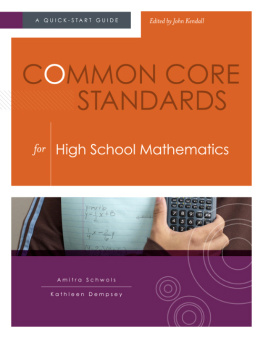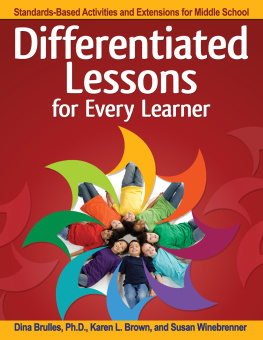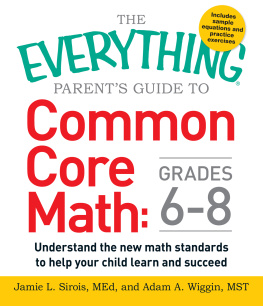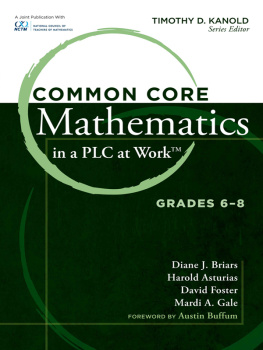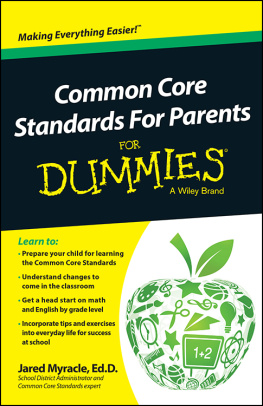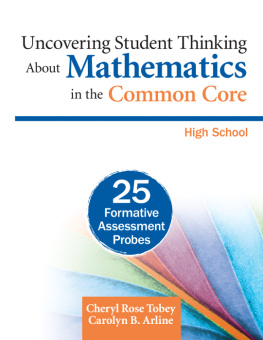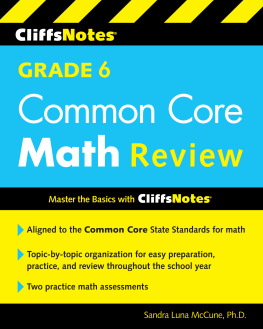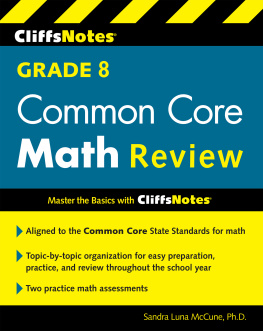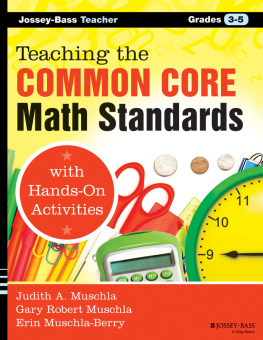Acknowledgments
....................
We would like to acknowledge Kirsten Miller and John Kendall for their crucial role in making our thoughts much more readable; Greg Gallagher and the North Dakota Curriculum Initiative committee, who provided us with valuable insights into the challenges facing teachers as they begin to work with the Common Core standards; Ceri Dean for her step-by-step guide to lesson planning; Amber Evenson for her collaboration and content expertise in developing the lessons; our McREL colleagues, who provided an analytical ear as we discussed the work; and our families, for supporting us as we worked on this project.
Introduction
....................
In July 2009, nearly all state school superintendents and the nation's governors joined in an effort to identify a common set of standards in mathematics and English language arts (ELA), with the goal of providing a clear, shared set of expectations that would prepare students for success in both college and career. The Common Core State Standards Initiative (CCSSI) brought together researchers, academics, teachers, and others who routed multiple drafts of the standards to representatives including curriculum directors, content specialists, and technical advisors from all participating state departments of education. By spring 2010, drafts were submitted for comment to the national subject-area organizations and posted for public comment. In June 2010, the final versions were posted to a dedicated website: www.corestandards.org. (A minor update of the standards was posted in October 2010.)
At press time, 45 states, as well as Washington, D.C., and two territories, have adopted the Common Core State Standards (CCSS) for mathematics. (Minnesota has adopted the ELA standards but not the mathematics standards. Texas, Alaska, Virginia, and Nebraska have indicated that they do not plan to adopt either set, although both Virginia and Nebraska have aligned the Common Core standards with their existing standards.)
Adoption of the standards is, of course, voluntary for states and does not include a commitment to any other programs or policies. However, states that have adopted these standards will be eligible to join one of two federally funded assessment consortia that are currently tasked with developing assessments for the Common Corethe Smarter Balanced Assessment Consortium (SBAC) or the Partnership for Assessment of Readiness for College and Careers (PARCC). Sharing assessments across states promises financial relief from notoriously expensive state assessments. In addition, federal programs such as Race to the Top have required that applicants demonstrate that they have joined with other states in adopting a common set of standards and an assessment program. Although states may form new consortia, many either have opted to join or are considering joining SBAC or PARCC.
Sharing a set of standards across states offers other advantages. For example, teachers' well-designed lesson plans targeting Common Core standards will be immediately useful to a large number of colleagues. The shared language of standards should also provide teachers with more opportunities to participate in very specific discussions about content, a process that has been hampered somewhat by the variety of ways states have described virtually the same content.
For a lengthier discussion of the Common Core standards, including their link to previous standards-based education efforts and the benefits and challenges the Common Core presents, see Understanding Common Core State Standards (Kendall, 2011), the first booklet in this series. We also encourage readers to explore numerous resources available at corestandards.org, especially the standards document itself (CCSSI, 2010c) and the guidelines for adapting standards instruction for English language learners (CCSSI, 2010a) and students with disabilities (CCSSI, 2010b).
About This Guide
This guide is part of a series intended to further the discussion and understanding of Common Core standards on a subject-specific and grade-level basis and to provide immediate guidance to teachers who must either adapt existing lessons and activities to incorporate the Common Core or develop new lessons to teach concepts not addressed in their previous state standards.
After an overview of the general structure of the Common Core standards for middle school mathematics, we consider each domain in turn, grade level by grade level, to examine how the standards it contains build upon and extend the skills students have acquired in earlier grades. We also explore the links between domains and highlight the mathematical practice standards with the strongest connections to each domain. Next, we focus on practical lesson planning with the Common Core, looking at a process for creating standards-based lessons that make the best use of the effective instructional strategies explored in Classroom Instruction That Works, 2nd edition (Dean, Hubbell, Pitler, & Stone, 2012). The guide concludes with an illustration of this process's outcome: three sample lessons that address Common Core standards identified as representing notable changes to middle school mathematics teachers' current practice.
Chapter 1
About the Common Core Mathematics Standards for Middle School
....................
The Common Core mathematics standards are organized into two sets: the Standards for Mathematical Content, designed to cross traditional course boundaries and cover all the conceptual mathematical understandings students need to develop from kindergarten through 12th grade, and the Standards for Mathematical Practice, which highlight the kinds of expertise that students must develop and use throughout this same grade span.
As we will show in this guide, the Common Core standards differ in many ways from most existing state standards documents, providing a greater level of detail about concepts, thought processes, and approaches. This level of detail often leads to much longer, more involved standards, some of which are up to a paragraph in length. Some of the standards detail conceptual methods of teaching and learning skills and concepts (e.g., applying the properties of operations to generate equivalent expressions, understanding that solving an equation or inequality is a process of answering a question). This is in stark contrast to many prior sets of state standards, which were far less explicit and typically used a single sentence to describe the skills and knowledge required of students. Another example of this detailed focus on the mental processes required in understanding mathematical concepts is found in the set of Standards for Mathematical Practice, which receives the same level of emphasis as the Standards for Mathematical Content.
In this chapter, we will walk you through the standards' structure, provide an overview of how the middle school mathematics standards fit together, and offer some guidance on what to focus on as you begin your implementation efforts.
The Standards for Mathematical Content
At the middle school level, the Standards for Mathematical Content are organized first by grade, then by domain, and finally by cluster. Each grade level's set of standards is introduced with a one- or two-page introduction, which consists of two partsa summary of the three to four critical areas (topics) for each grade, and an in-depth narrative description of those critical areas. Figure 1.1 provides a brief, grade-by-grade summary of the critical areas for middle school.
Figure 1.1 | Critical Areas Within the Middle School Mathematics Domains by Grade Level


